The History of the Comet Goldfish:
The Comet Goldfish is native to the United States of America. In fact, it is one of two goldfish breeds that originated here.
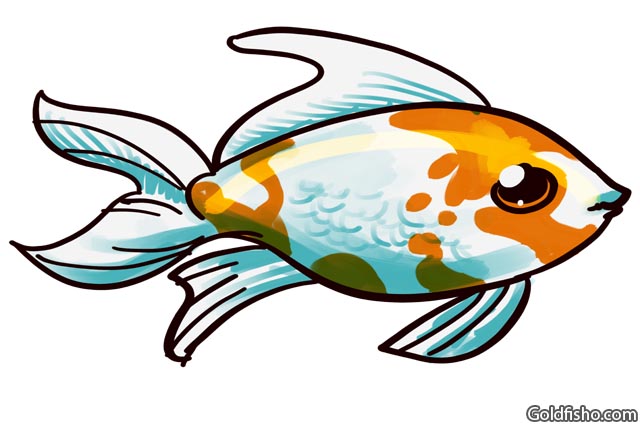
One theory of how the Comet Goldfish came to be is thought to involve the Ryukin Fancy Goldfish or the Red Fantail Fancy Goldfish.
While both of these fancy goldfish varieties are chubbier than the Comet, it is possible that selective breeding may have taken place to produce eventually a goldfish with a slim body, flowing fins, and varying colorations.
Another theory begins in 1880 (only 30 years after goldfish were introduced to the United States of America and all of North America).
The Comet Goldfish may have developed in outdoor ponds owned by the United States Government in Washington D.C.
The final theory of how the Comet Goldfish began involves an American pioneer by the name of Hugo Mulertt. He is thought to have started breeding Goldfish and thus produced the Comet Goldfish.
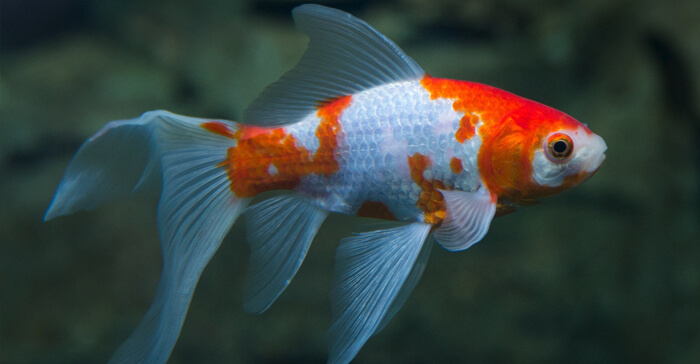
He is also believed to be the creator of the name of these slender goldfish.
Physical Traits of the Comet Goldfish:
The Comet Goldfish is one of the most popular breeds of goldfish in the United States. They are commonly found in pet stores as well as aquariums of all shapes and sizes.
This wide-spread acceptance is due to the fact that the Comet Goldfish is bred in vast numbers compared to most goldfish breeds. They are also very well-liked because they are a hardy breed.
Meaning, they can live happily in cooler temperatures although they should never be too low for too long.
The Comet Goldfish is a beautiful, slender fish that has a similar body shape to that of the Common Goldfish. Both are slim in physical appearance and very agile swimmers.
The Comet, however, has longer flowing fins, dorsal fin, and caudal fins whereas the Common Goldfish has round fins that are stiff rather than flowing.
The Comet can be a variety of different colors and patterns. The most traditional coloration is the yellow-orange, orange-red color ranges.
They can also come in several different patterns including calico. This particular calico pattern is unique in that is appears as red and white patches that over the entire body of the Comet Goldfish.

These Comets are usually specified as the Sarasa Comet (which is Japanese for the Calico Comet). Their scales are shiny and metallic in appearance, but, smooth.
Their scales should never be bumpy like the Pearlscale Fancy Goldfish unless they have contracted an illness or parasite.
The Comet Goldfish should always have a single caudal fin (tail fin) that is long and flowing with a deep fork and pointed tips. They should always have a visible dorsal fin that is of short to medium length.
The eyes of the Comet Goldfish should be normal, not buldging or telescoped.
Difficulty of care of the Comet Goldfish:
The Comet Goldfish is one of the easiest goldfish breeds to own. As previously mentioned, they are a hardy goldfish breed that can survive in cooler temperatures.
However, they should be kept in a stable water temperature, preferably around 70ºF. These goldfish are a fantastic choice for first-time goldfish owners.
Related: Proper Goldfish Water Temperature
This is due to their basic goldfish care needs as well as their graceful appearance.
Common Goldfish are another excellent choice for first-time goldfish owners, and they require similar needs as the Comet Goldfish which makes them perfect tankmates.
However, some people might find that the Common Goldfish is not as appealing to look at as the Comet Goldfish and would, therefore, prefer the Comet.
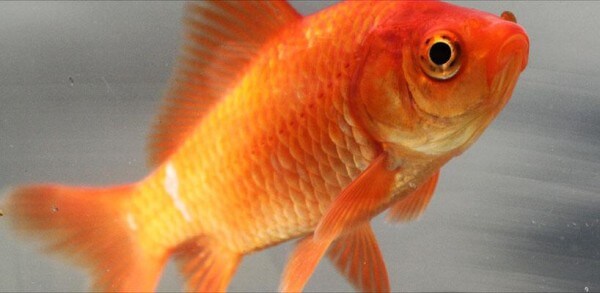
They will not become injured nor would they be at risk of injury in a tank with décor, filtration systems, or other objects in the tank with rough edges.
In fact, their swimming abilities and slender body shape should keep them from being affected by these items (unlike more delicate goldfish breeds such as the Pearlscale Fancy Goldfish, Bubble Eyed Fancy Goldfish or Telescope Eyed Fancy Goldfish).
If you are considering starting a Comet Goldfish aquarium or an outdoor pond with goldfish inside of it, then you should make sure that you are providing a healthy environment for them.
Goldfish require filtration regardless of the habitat.
The filtration ensures that the water they are living in is safe for them and free of harmful bacteria.
Related: 5 Great Filters For Your Goldfish Tank
If you would like to use tap water to fill the tank or pond, then you will need to purchase a water conditioner.
The water conditioner clears the tap water of harmful heavy metals and chlorine (which are toxic to fish).
You should never overpopulate your Comet Goldfish environment.

The rule of thumb to follow for a safely populated goldfish aquarium or outdoor pond is to plan at least 20 gallons of water per fish.
For example, if you want 3 goldfish in the habitat then you should prepare to purchase at least a 60-gallon aquarium.
This may seem excessive. However, the Comet Goldfish do not stay small for very long, and they require room to grow, swim and plenty of oxygenated water for them to breathe.
Most species of fish will continue to grow (growth rates will vary by species) until they die. Giving them the space to grow is just one of the many ways that you are helping your fish be happy and healthy.
Your Comet Goldfish aquarium should go through a “water change” every other week. 30% of the tank water should be replaced, and the new water should be treated with water conditioner before being added to the tank.
Filter parts or décor that need to be cleaned should be in the tank water that had been removed.
Rinsing or cleaning them in untreated tap water may cause your fish to go into shock when the object is returned.
Also, you may rinse away the beneficial bacteria.
Gravel and fish should never need to be removed from the aquarium during a cleaning. Gravel can be cleaned by using a gravel vacuum.
[tcb-script async=”” defer=”” src=”//www.instagram.com/embed.js”][/tcb-script]
Nutrition and Feeding the Comet Goldfish:
You may think feeding Comet Goldfish is a piece of cake. You may believe that goldfish only eat Goldfish Flakes or Goldfish Pellets.
However, this is not the whole truth!
Yes, goldfish can be fed these products, and they are readily available at any local pet store.
However, goldfish actually enjoy a variety of different types of food.
Comet Goldfish are omnivores so they will happily consume plant sources as well as meat sources.
Now, don’t think that you can offer your goldfish a pound of ground beef and that they would be happy to eat it.
The truth is, their meat sources are a little different. Goldfish, like the Comet Goldfish, enjoy:
- Insects
- Worms
- Ants
- Mosquito Larvae
- Brine Shrimp
- Flies
- Bloodworms
Comet Goldfish will happily accept any one of these meat sources as a protein filled meal.
On the other hand, goldfish also enjoy plant source meals such as:
- Plants (usually they will nibble on the live plants you place inside the tank)
- Vegetables including broccoli, mashed peas, and lettuce
- Fruits including blueberries and strawberries (cut up)
- Algae (they will usually nibble on the algae growing inside the tank)
- Leaves
- Plant roots (goldfish are diggers, and they may uproot a live plant to nibble on the roots)
When choosing what to feed your Comet Goldfish, you should consider mixing and matching the above items with their regular goldfish food.
For example, you may want to feed your Comet Goldfish some goldfish flakes as their first meal, a few worms as their second meal and finally some leaves or lettuce as their third meal.
Goldfish should be fed two to three times per day. Generally, they should be fed morning, afternoon and evening. However, this will depend on your schedule as well.
Goldfish flakes and pellets are good choices for a quick meal (usually provided during your busiest time of day).
Regardless of what you are feeding your Comet Goldfish, or when you are feeding them, you should never overfeed them.
Goldfish are instinctual munchers. This suggests that they will eat just about anything at any time, and they can quickly become overweight if you allow this.
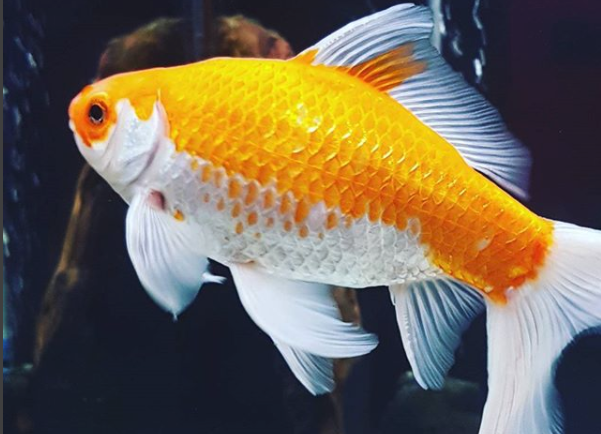
While this particular breed of goldfish may not pack on the pounds as quickly as other goldfish breeds (as a result of their incredible swimming speed and agility), they can still suffer from multiple health problems that are caused by overfeeding.
Therefore, you should only provide your Comet Goldfish with the amount of food that they can finish eating in two to three minutes time. Uneaten food will only sink to the bottom of the aquarium, become moldy and pollute the water.
Habitat Requirements of the Comet Goldfish:
A Comet Goldfish can continue to grow if provided the space to do so. They should be kept in a rectangular shaped habitat.
Rectangular aquariums or outdoor ponds offer your goldfish adequate surface area for swimming, growing as well as quality oxygenated water for breathing.
As previously mentioned, the Comet Goldfish is a hardy fish and therefore it should not be easily damaged by the filtration device, décor, or other objects inside the tank.
Contrary to popular belief, they do require a filtration system that offers mechanical, biological and chemical filtration.
These three systems will ensure that floating debris and other things inside the water are removed. As previously mentioned, Comet Goldfish require a habitat that is not overpopulated with other inhabitants.
Each goldfish should have about 20-gallons of water. Therefore, if you have four Comet Goldfish, then they should be living in an 80-gallon tank.
This rule of thumb is set to provide adequate living conditions for the inhabitants without them swimming into each other.
Another problem that could occur if a tank is overpopulated is excessive pollution.
More residents living in a single environment creates more waste. The more waste that is in the water (that they use to breathe) the less oxygen is available.
Personality and Temperament of the Comet Goldfish:
Comet Goldfish are very agile swimmers and therefore would be very enjoyable to watch. They tend to be very active and will swim quickly when excited.

Goldfish can recognize their owners and will even anticipate their arrival. They can also recognize their tankmates and their décor.
It is recommended to change up the scenery in the tank once in a while to keep your goldfish interested and entertained.
The Comet may become aggressive during feeding time especially if there is a lot of competition for food.
Potential Health Problems of the Comet Goldfish:
Comet Goldfish may be prone to a variety of health problems, especially if they are not adequately cared for. These health conditions include but are not limited to:
– Goldfish ICH: Ichtyopthirius Multifiliis is a parasitic condition that creates a marked effect on the goldfish’s scales. This disease is also known as White Spot Disease after the spots that appear suddenly.
– Swim Bladder Disease: a common balance disorder amongst fish. This can be the result of various other health problems including constipation, parasites, or poor nutrition.

– Fin Rot/ Tail Rot: this is a symptom of an underlying condition. This is a sign that shows as an apparent “rotting away” of your goldfish’s fins or tail. Causes of this symptom include bacteria, parasites, fighting with other fish, and stress.
– Anchor Worm: A highly contagious crustacean common amongst Koi fish and Goldfish. These crustaceans cause your fish to demonstrate body rubbing as well as experience inflammation and respiratory problems.
– Fish Lice: Also crustaceans that are common in outdoor pond inhabitants. The fish will exhibit body rubbing, loss of color, as well as loss of appetite. These crustaceans can inject the fish with viruses and bacteria which could cause further health problems.
– Ulcers and Tumors
– Fungal Infections
Final Thoughts to sum up:
The Comet Goldfish is a lovely goldfish breed that can be very enjoyable to own. They are a popular choice among goldfish enthusiasts as well as first-time goldfish owners.

The Comet Goldfish is a hardy breed that can happily tolerate below average conditions. However, they should be well-kept out of care and respect for them as living creatures.
Close observation can help you spot an illness, parasite, or disease quickly which then you can treat immediately.
Consult a goldfish specialist to confirm a diagnosis before treatment. Avoid buying fish or supplies from breeders or pet stores that are dirty or seem to mistreat their animals.
With this in mind, you should also avoid buying your fish online as much as possible.

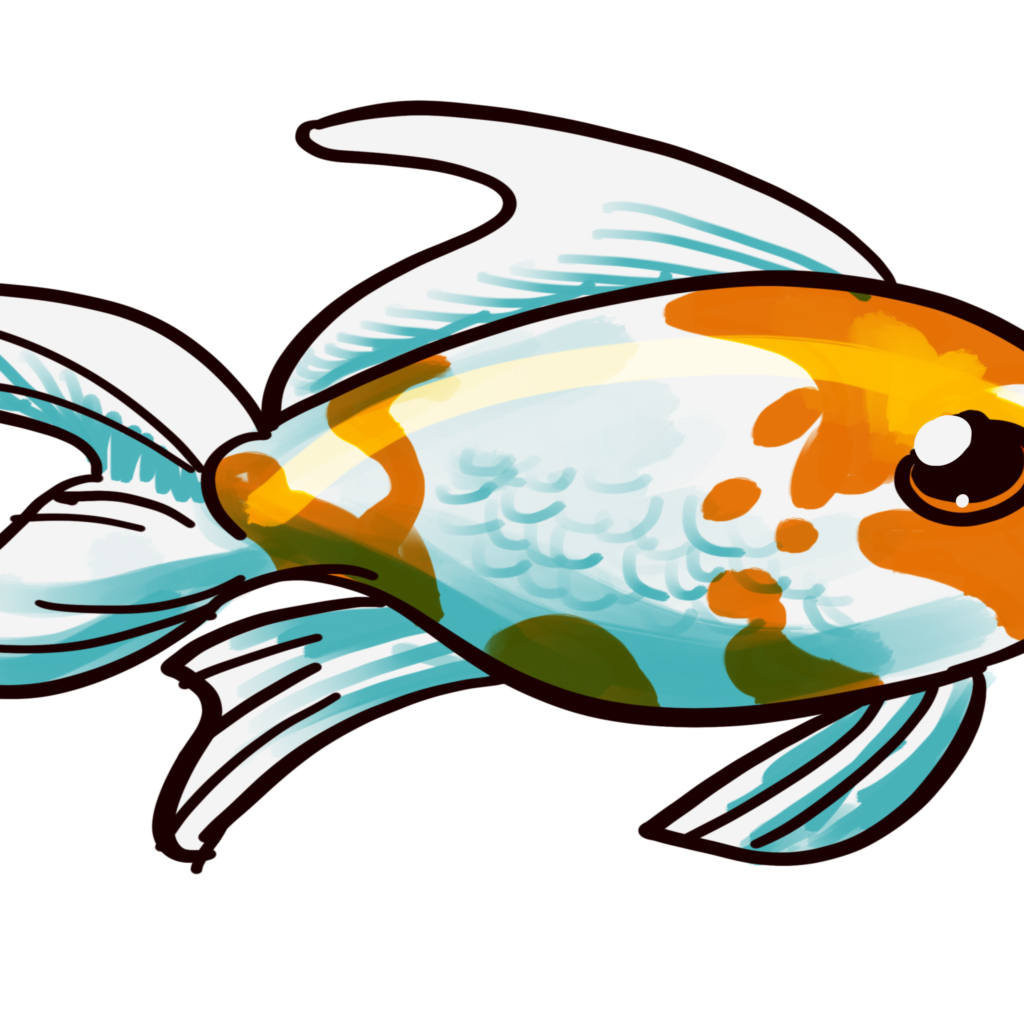
 (@amazing_goldfish_love)
(@amazing_goldfish_love)